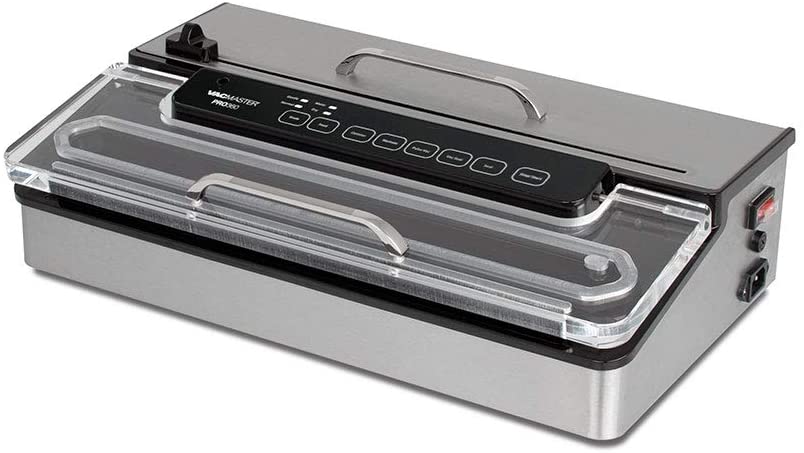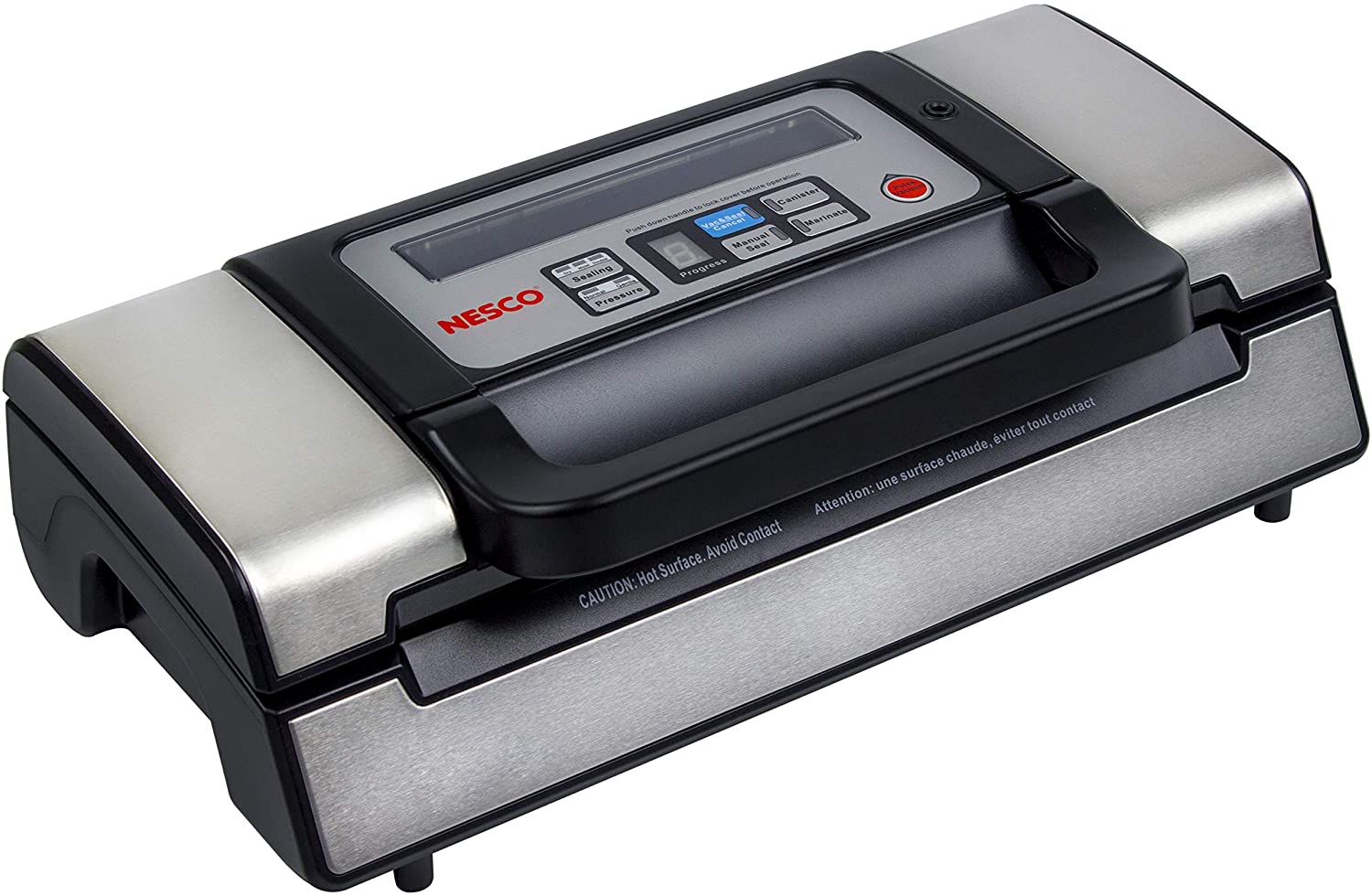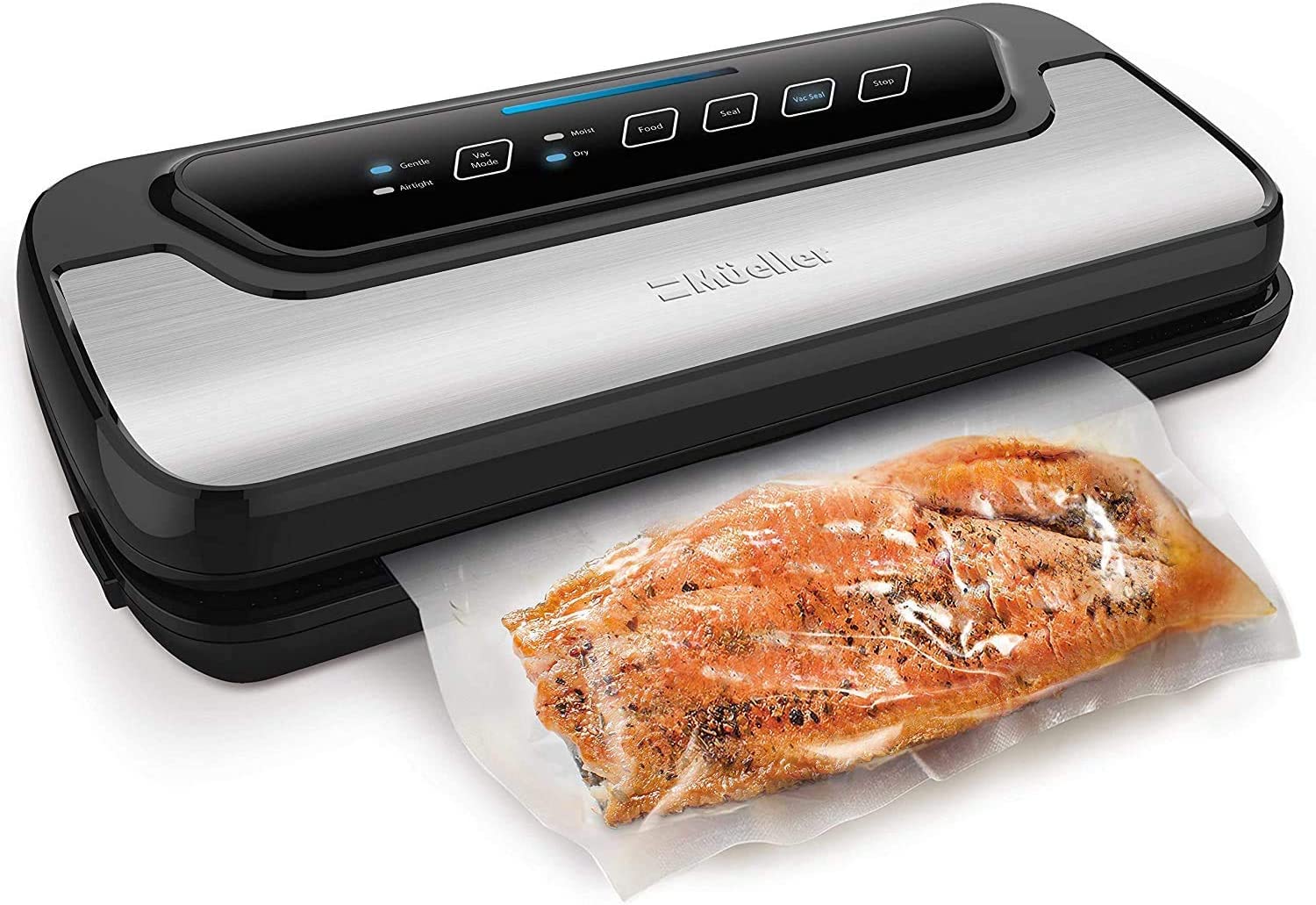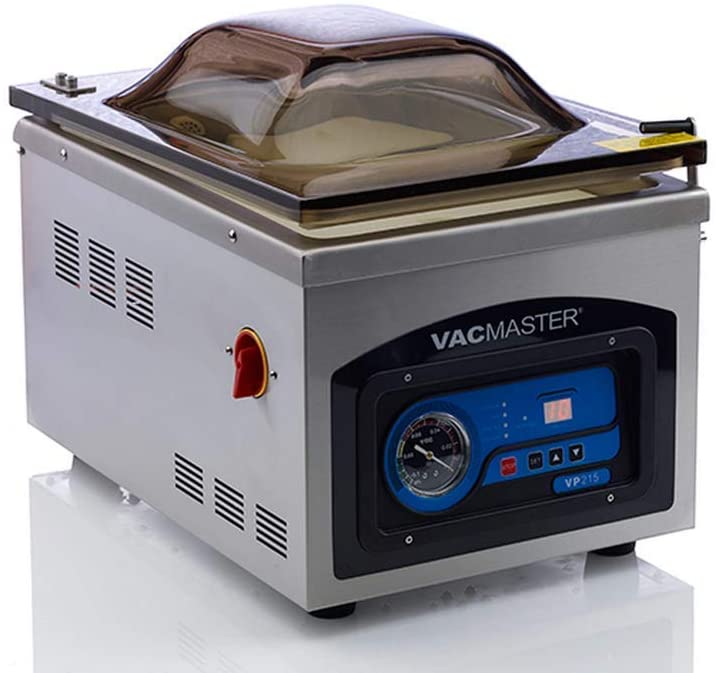The Best Vacuum Sealers for Your Money
No one likes it when food gets spoiled or loses its taste. Spoiled food is especially annoying for people who buy in bulk to save money or cut down on trips to the grocery store. If you're tired of forcing yourself to eat juiceless fruit and freezer-burned chicken, or worse yet, throwing out half your fridge come trash day, it may be time to invest in a vacuum sealer.
Preservation methods such as vacuum sealing can extend the life of your food — it can keep frozen meats safe for up to two years, for example. Vacuum sealing can also add to the length of time that food tastes fresh and delicious. That's right, there's a way to avoid soggy greens, tasteless orange slices and stale muffins (yes, you can vacuum seal snacks to keep them tasty for longer).
With vacuum sealing, you place food items inside a bag — which you can buy in different sizes or in a roll so you cut them however long you want — and then seal one end first. (Every machine has a dedicated button to seal without vacuuming.) Then you extract all the air out and seal it completely. Removing the oxygen surrounding the food prevents bacteria from forming, so the food will remain safe for consumption for more than three times longer than it would otherwise.
Food can keep a lot of its freshness thanks to vacuum sealing, as this preserves its moisture and keeps it from being exposed to oxygen (which makes things deteriorate faster). It also prevents freezer burn because there’s no moisture left inside the bag to condensate and freeze. In other words, with vacuum-sealing, freezer-flavored steaks might be a thing of the past.
Vacuum sealing is excellent for people who buy in bulk, meal prep often or want to set up their food in portions for quick access. You can, for example, vacuum seal individual chicken portions in the freezer and not have to struggle separating the pieces when you’re ready to cook.
Types of vacuum sealers
Vacuum sealers come in a wide variety of sizes, designs and capabilities, across a wide range of prices. Here are the options:
• External suction vacuum sealer. This is the most common type of vacuum sealer. It’s a relatively thin, elongated appliance with a clamp-style opening. You place the end of your bag on the sealer's heating bar and close the lid; the sealer sucks the air out and the heat seals the bag. These sealers are usually inexpensive, starting at around $30, but prices can range up to $300. The bigger and more expensive models have features like integrated bag storage and cutters, marinating mode, pulse mode and more.
While these work great for solid food, overall, external suction vacuums don’t handle liquids well. Just as the vacuum sucks out the air, it’ll also start extracting the liquid. This not only makes the food lose moisture and flavor, but prevents a perfect seal and can possibly put the machine in jeopardy. There are exceptions, though; some professional-grade models can handle small amounts of liquid, like marinades.
External vacuum sealers need a specific type of bag with a mesh texture. This is necessary to prevent the bag from moving when sucking the air out, but mainly so that there are orifices for the air to escape while the opening is clamped. The important takeaway for consumers is that the specialized bags needed for external vacuum sealers are more expensive than regular plastic bags.
• Chamber vacuum sealer. Chamber vacuum sealers are very large and box-like, as opposed to the rectangular form of external sealers. The bag being sealed in a chamber vacuum is placed inside the appliance, in what’s actually called the chamber.
These kinds of sealers are mostly used in commercial settings, and they are very large, ranging from 25 pounds and roughly the size of a microwave to over 300 pounds and the size of a chest freezer. There are some models with up to four separate seal bars and chambers that fit bags of up to 28”. They are expensive too, normally surpassing $1,000.
Chamber vacuum sealers are far more versatile than their external suction counterparts. Instead of sucking air out of the bags, they work by creating a vacuum inside the entire chamber and equalizing the inside of the bag with the outside. This is why they can work effectively with liquids and allow users to seal soups, stews, heavily marinated foods and more. They can even vacuum seal glass jars, though it’s not the same as pressure canning. However, using glass jars is good for sealing already long-lasting dry foods like flour, rice and nuts.
You can even use a chamber vacuum sealer to infuse foods with marinade, as the vacuum created helps push fluids into meats and vegetables. You can do this with certain external vacuum sealers as well, although not as easily and with more risk of spilling.
Finally, far more bags are compatible with chamber vacuum sealers since they don’t need any special texturing. This could save you money in the long run, especially if you use sealing in a business.
• Handheld vacuum sealers. Unlike the other two kinds of vacuum sealers, handheld models are very small. They are used to suck the air out of bags or bowls that are closed by hand, just like space-saving bags used for clothing.
Handheld vacuum sealers normally cost under $50, but are often only compatible with bowls or bags from the same brand. Nevertheless, they have advantages beyond affordability. While the seal is not as tight as with heat-sealing models, they’re a great option for short-term storage and, most of all, when you want reusability.
Vacuum sealer buying guide
In addition to thinking about what kind of vacuum sealer you want, it’s a good idea to look at the different features and specifications. Among the factors to consider:
• Bar length. The bar is where you place the end of your bag and seal it with heat. The longer the bar, the wider the bags you can use with the machine. Most bars range between 8” and 12”, but commercial-grade external suction machines can go up to 16”. Chamber vacuum sealers can offer multiple separate bars of up to 32” each for sealing even more bags simultaneously.
For the average household, an 8” to 12” bar will be more than enough. Still, if you vacuum seal often, a longer heating bar might be convenient because you can seal two bags at a time, speeding up the process and saving you time.
• Modes. Generally, a vacuum sealer will extract as much air as possible and then seal the bag automatically. However, some models have a timer or a gentle mode for food that can’t handle the pressure of a fully vacuumed bag, like baked goods or chips. There are also moist modes that extract air more gently to avoid over extraction of liquid or moisture and heat up for longer to ensure sealing despite any moisture in that area of the bag.
There is also pulse mode, which gives a way for users to control the extraction of air instead of letting the machine do it automatically or with a timer. This is particularly useful for foods that could crumble or get crushed with the pressure, such as potato chips, muffins or non-frozen bananas. If you tend to keep these types of food around, this feature is a good one to have.
• Closing mechanism. The closing mechanism can be an important characteristic, especially when it comes to external vacuum sealers. Some have small latches on the side, some have a big lever on top, some have a dial on the right, and some you have to actually hold down while they vacuum and seal. Depending how much and how frequently you use the machine, you might want to ensure that closing the lid is not an additional hassle.
Best vacuum sealers
1. Best overall: NutriChef Automatic Vacuum Air Sealing System
Bar length: 7.8”︱Available modes: Dry, moist︱ Weight: 2.93 lbs
The NutriChef Automatic Vacuum Air Sealing System is the ultimate solution for elevating your food storage game while minimizing kitchen waste. Say goodbye to the frustration of spoiled food, freezer burn, and discarded leftovers. This cutting-edge kitchen appliance is designed to extend the freshness, flavor, and shelf life of your favorite ingredients. That way, every bite is as delicious as the day it was prepared.
With its advanced vacuum sealing technology, this system empowers you to take control of your food preservation like never before. By removing air from vacuum-sealed bags and creating a secure, airtight seal instead, this device locks in the rich flavors and essential nutrients of food. With this vacuum air sealing system, you can savor the natural taste of garden-fresh produce and enjoy the succulence of marinated meats for days to come. You can even relish the wholesome goodness of pantry staples without deterioration.
This product has the remarkable ability to enhance food preservation. Whether you're storing perishables or leftovers, the technology employed ensures that your food stays fresh for longer periods. This not only reduces waste but also adds convenience to your daily routine. With this product in your kitchen, you can plan meals efficiently without worrying about items going bad. The product's versatility and customization options are worth highlighting as well. It has been designed to adapt to a wide range of storage needs.
The customizable features allow you to adjust settings according to the specific requirements of different food items. This not only optimizes the preservation process but also offers a level of undeniably valuable flexibility. The compact nature and user-friendly interface of this product make up its intricate design. For $83, this automatic vacuum air sealing system is a steal, making it the top choice on our list.
2. Best design: VacMaster PRO360 External Vacuum Sealer
Bar length: 16”︱Available modes: Dry, moist, gentle, marinate, pulse︱ Weight: 16 lbs
You’ll see the VacMaster name frequently when searching for vacuum sealers. The company makes commercial-grade vacuum sealers to fit most professional needs, as well as the needs of avid sealers at home. Retailing for around $300, the PRO360 is one of the best external sealers you can find, and it’s actually cheaper than a lot of competitors, which can surpass $500.
It has a 16” heating bar, which is more than the average 8” to 11”, and enough to seal two 7.8” bags (a common bag measurement) simultaneously. It has a wide array of modes for almost any type of food you can imagine. The average dry mode works for regular dry or frozen food, while you may want to use the moist mode for marinated meats or vegetables, gentle for delicate items like soft cookies, and pulse mode for a customized level of air extraction. This makes the Pro 360 one of the most versatile external suction vacuum sealers in the market.
On top of that, there’s a marinating option via the external hose attachment. You can plug the included hose and connect it to a VacMaster canister (sold separately) and either seal the canister or use it to marinate foods. The machine pushes and pulls air at a regular pace to help infuse the food with the marinade. Although the process is not as easy as with a chamber vacuum sealer, it’s a good perk to have.
The PRO360 comes with storage space for a roll of bags and a cutter, so it’s a full vacuum-sealing station by itself. It also has a cooling fan to prevent overheating due to frequent use. (Overheating can be a problem on other machines since high heat is used to seal the bags.)
3. Editor’s pick: Nesco VS-12 Deluxe Vacuum Sealer
Bar length: 11.8”︱Available modes: Dry, moist, gentle, marinate, manual stop︱ Weight: 10 lbs
For home users that require high quality and versatility, the Nesco VS-12 almost seems like a no-brainer at around $100. That’s over $100 less than professional-grade machines, and not much more than the typical $80 vacuum sealers, which are not nearly as feature-packed.
The Nesco VS-12 has as many modes as more expensive models, providing the regular dry mode, a moist mode and a double-sealing moist setting for foods with a lot of moisture or marinade. This double-seals the bag to ensure that the liquids don’t interfere with the closure. It also has gentle mode and a version of pulse mode. While you can’t just push a button on the VS-12 and make it extract air at will, you can turn it on and then physically stop it with the “manual seal” button whenever you think it’s enough. The machine will stop taking out air, and then start sealing the bag to finish the process.
Just like the VacMaster PRO360, the Nesco has a marinating mode that uses an external hose connected to a canister. It pushes and pulls air to aid in the infusion of flavor to your food. You can also use the hose to simply vacuum seal food inside the canister.
With a good bar length of 11.8”, all the possible features available on an external suction sealer and a reasonable price, the VS-12 is the perfect option for people who take their vacuum sealing seriously but don’t need industrial power and size to do it.
4. Best for low prices: Mueller MFFVS-01 Vacuum Sealer Machine
Bar length: 8”︱Available modes: Dry, moist, gentle︱ Weight: 2.7 lbs
Of all the $40 to $80 vacuum sealers out there, the Mueller stands out for more than just its German name. It matches all the stainless steel appliances in your kitchen, it’s lightweight and compact, it has most of the modes you need, and it comes with the accessories other companies usually sell separately. At roughly $70, you can’t ask for much better.
With a bar length of 8”, it fits one of the most common bag sizes in vacuum sealers, 7.8”. While that’s not very big, it can help you protect most household food items and portion them out.
Note that the length of the bag can be up to you; the measurements above just refer to the width. You can buy a large roll of the bag plastic and make your own bags at whatever length you need. Just be sure to seal one end first with the dedicated “seal” mode. You could easily seal 10” frozen bananas for smoothies, for example.
If you want to seal a big rack of ribs, on the other hand, then you might find yourself in a pickle. (The pickle does fit, though.)
The Mueller has three modes, including moist and gentle, which are important to avoid crushing soft desserts and/or problems with marinated meats. It also has a port for an external hose (included) that you can use to seal vacuum canisters. Canisters are not included, unfortunately, but it does come with five bags and a 79” vacuum bag roll, so you can get started right away.
5. Best for low prices runner-up: FoodSaver VS0160 Sealer PowerVac
Bar length: 11”︱Available modes: Dry, moist︱ Weight: 5.4 lbs
This vacuum sealer by renowned brand FoodSaver is not only practical, it stands out for its looks too, as it’s sleek and designed to be stored either horizontally or vertically in your kitchen. It also comes with the perks of a 3-year warranty (two years longer than most) and a solid reputation in the food preservation industry.
It has two simple modes: wet (same as moist in other models) and dry. You can also attach an external hose and vacuum seal FoodSaver branded canisters. Neither the hose or the canisters are included, however. This is where the VS0160 falls a little short when compared to the Mueller, which has more modes and includes attachments.
However, it does include a long 8-foot vacuum bag roll so you can cut your own bags however long or short you need them.
This is a solid product with a very good warranty and a lot of FoodSaver products that can complement it. It also has a longer sealing bar at 11”, which opens up possibilities. For $60, it's a great value.
6. Best handheld vacuum sealer: FoodSaver Cordless Vacuum Sealer
Courtesy of Amazon
Courtesy of Amazon
Bar length: N/A︱Available modes: N/A︱ Weight: 1.05 lbs
If you just want to make sure your groceries last a little longer, or want to food prep for the entire week, a handheld vacuum sealer with a set of canisters might be good enough. The FoodSaver Cordless Vacuum Sealer fits those requirements to a tee, especially due to the large accessory catalog from the brand.
It has a charging base where it can be kept 24/7. When it’s time to use it, just put it on top of the opening of any FoodSaver zip-top bag or vacuum-sealing canister and suck the air out by pressing the button. You can control how much air you take out, so it’s good even for brittle items like potato chips.
Although the bags do lose some seal strength over time, both canisters and bags are reusable, eliminating the added cost (and waste) produced by vacuum sealing in bags you have to throw away. You can even get adapters for glass jars.
7. Best chamber vacuum sealer: VacMaster VP215 Chamber Vacuum Sealer
Bar length: 10”︱Available modes: Timer︱ Weight: 84 lbs
Chamber-style vacuum sealers are the heaviest duty options for vacuum sealing. They’re big, heavy and expensive and provide unmatched versatility along with power and durability. At $1,000, the VacMaster VP215 is a prime example, weighing 84 pounds and sporting an oil pump that can last a lifetime with proper maintenance.
The VP215, like other chamber-style vacuum sealers, doesn’t suck air out of a bag. Instead, it sucks the air out of the entire chamber and equalizes the pressure in both chamber and bag without making a mess.
This opens up a lot of possibilities for preserving food and even how you cook. You can easily vacuum seal any liquid, even plain water (hey, it’s good for long-term survival purposes), so you can store stews, soups or heavily marinated meats and vegetables without any hassle. You can also vacuum seal jars with dry goods inside such as rice or coffee beans. And you can actually use it to infuse marinades more quickly and efficiently thanks to the pressure the vacuum creates.
Other than the price and enormous size of these vacuum sealers, it’s important to note some other potential downsides like the size of the chamber and the lack of control. First, the chamber on the VP215 is only 10” x 13”, so anything you want to vacuum seal has to fit those dimensions — the heating bar is only 10” as well, shorter than much cheaper external models. (By contrast, there’s a width limit on external clamp-style vacuum sealers, but the bag can be as long as you want.)
Second, the VP215 works with a timer and doesn’t offer any other mode. The absence of a pulse mode can be a particular inconvenience, since this can result in crushed potato chips or crumbled banana muffins if too much air is taken out.
However, this VacMaster shines in terms of power and durability. It has an oil pump that can work just fine for years, provided you give it the maintenance it needs. Other styles can degrade much faster over time.
If you want the most versatility, and you vacuum seal on a regular basis or even at a professional level, the VacMaster VP215 will make life much easier. If you can look past the $1,000 price tag, you’ll have all your needs met with a single machine.
More from Money:
The Best Pressure Canners for Your Money





